I am familiar with the known formula to find Reynold's number in a circular pipe for newtonian fluids:
$$\text{Re} = \frac{\rho \bar{v}D}{\mu}$$
where $\rho$ is the density, $\bar{v}$ is the average velocity, and $\mu$ is the viscosity of the newtonian fluid; and $D$ is the inner diameter of the pipe.
At first, I presumed finding the $\text{Re}$ value for a non-Newtonian fluid is pretty straightforward: replace $\mu$ with whatever is equivalent for a non-newtonian fluid. I know that newtonian fluids hold the property that the viscous shear stress on any infinitesimal surface $dS$ is proportional to the velocity gradient along the normal of $dS$:
$$\tau \propto \frac{dv}{dz}$$
where $\tau$ is the viscous shear stress. Of course, the proportionality constant here is $\mu$.
For non-newtonian fluids, the shear stress is not proportional to velocity gradient, but still remains a function of it:
$$\tau = f\left(\frac{dv}{dz}\right)$$
Various types of non-Newtonian fluids have been experimentally discovered, such as pseudoplastics and dilatants, with their shear-stress and shear rate (velocity gradient) relations:
I thought we must use the "viscosity-equivalent" for non-Newtonian fluids:
$$\mu_{\text{equiv}}=\frac{\tau}{\gamma}$$
where
$$\gamma = \frac{dv}{dz}$$
This becomes:
$$\mu_{\text{equiv}}=\frac{f(\gamma)}{\gamma}$$
This "viscosity equivalent" becomes a function of shear rate. This is where I hit a roadblock:
-
In a circular pipe, the shear-rate at different distances from center are different, and thus, the "viscosity equivalent" is different at every point in the pipe. What should I substitute $\mu$ with in the newtonian formula to get my result for any non-newtonian fluid?
-
If my entire premise was wrong, I would like to know how I may obtain the Reynold's number for a non-Newtonian fluid.

Best Answer
I am no expert on non Newtonian fluids, but to me it looks like (unless you have a special type of viscosity) you can't. A non Newtonian fluid is more complicated than a Newtonian one and can not be described by a single dimensionless parameter. I will illustrate this with a specific example of 'shear stress'-'velocity gradient' relation (I guess the 'dilatant' fluid):
$$ f(\gamma) = \mu \gamma + \nu \gamma^2 \, .$$
Making everything dimensionless as for the Newtonian fluid, you can define $ Re = {\rho \bar{v} D}/{\mu}$, as before. You are however stuck with the $\nu$ parameter, which provides a second dimensionless number. For example you can define
$$Re_{nN} = \frac{D^2 \rho}{\nu \bar{v}}\, .$$
I use the index ${nN}$ to signify that that $Re_{nN}$ is a dimensionless number (just like $Re$) that quantifies the non Newtonian viscosity. If $Re_{nN} \gg 1$, ($\nu$ is small and) the non Newtonian viscosity is not important. The opposite happens when $Re_{nN}\ll 1$.
There are however two numbers. The fluid is approximatively Newtonian if $Re \ll Re_{nN}$, and it is far from being Newtonian when $Re \gg Re_{nN}$. I guess that you need $Re \gg 1$ and $Re_{nN} \gg 1$ if you want to reach a turbulent regime and that the flow will be laminar if either $Re \ll 1$ or $Re_{nN} \ll 1$, but we are now entering into the specifics of non Newtonian fluids of which I know nothing. The takeaway message is (unfortunately) that non Newtonian fluids are complicated and depend on more than one parameter.